Syngonium: types and care at home
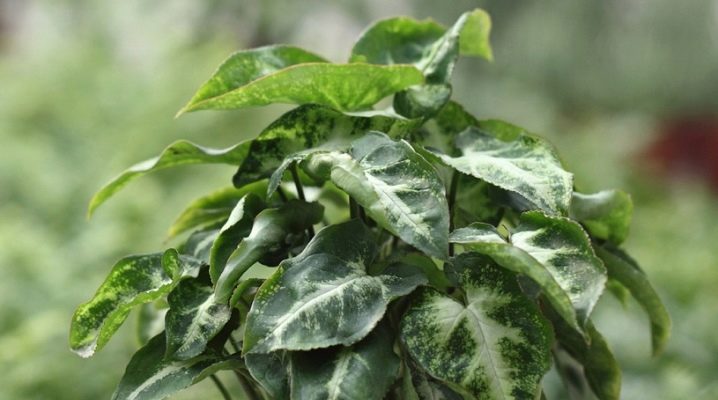
An unusual evergreen perennial plant called syngonium has won love and popularity among flower growers. It is not difficult to grow it at home, since the plant is hardy, unpretentious and has beautiful decorative leaves, which, depending on the type and variety of this perennial, have a different structure and color. The flower came to us from the tropics of South America.
It has adapted well enough and got accustomed, easily and unobtrusively fitting into almost any interior - be it an apartment or an institution. A plant may even bloom unexpectedly, but such an event is more often an exception than a pattern.
Having made friends with this plant, people began to attribute unusual properties to it - it is believed that the syngonium growing in the house protects its inhabitants from diseases, improves the general emotional atmosphere and attracts good luck.
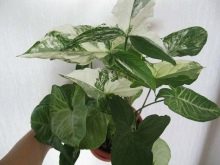

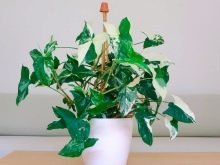
Description
Syngonium is an evergreen liana, it belongs to the Aroid family, and then the plant is classified according to the type of structure of its leaf plate. The Aroid family is more common in the tropics and subtropics, it is from there that the indoor flower syngonium originated. Like many vines, syngonium has aerial roots, which it needs for rapid growth and clinging to support.
The thickness of the shoots of a plant varies from 5-6 millimeters to several centimeters. Vine shoots are not prone to branching independently, but if you pinch them on purpose, branching is quite possible.
The flower grows very quickly and in 12 months it can add up to 60 centimeters in growth. If the plant is provided with good lighting and timely correct watering, then at home it can grow up to 2 meters.
The aerial roots of the vine begin their growth in the stem internodes, then the direction of growth of such a root goes down, and then, reaching the soil, the root takes root, and new young shoots grow in this place. The underground root system of the syngonium supplies the plant with moisture and nutrients, and also allows the flower to firmly anchor in the soil.


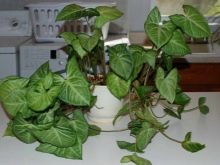
The structure of the leaf in a perennial vine depends on the type of plant. The most common are heart-shaped, oval, arrow-shaped and feathery forms. The syngonium has one feature - young leaves, regardless of the type of plant, all have an oval structure, but in the process of growth and development, the leaf takes on one shape or another and is divided into lobes. The color of the leaves of this perennial is also diverse - it can be monotonous green or variegated with white or pink blotches of varying width and intensity. In addition, there are plant species whose leaves resemble milk chocolate in color. There are quite a few leaves on the liana, they are often located and form a dense cover. It is noteworthy that with the arrival of winter, the foliage on the liana does not fade or fall off.
Syngonium has an amazing property - the ability to predict rain... The plant is so sensitive to changes in weather and high humidity that a couple of hours before the onset of atmospheric precipitation in the form of rain, an abundance of small drops of water can be noticed on the leaves of the vine. You can safely trust this home barometer as it is never wrong.
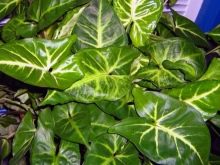

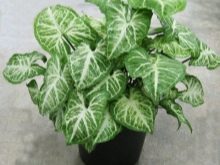
Types and varieties
The main types of vines that are adapted for growing at home are auricular, pedunculate and Wendland.
- Eared, or, as it is also called, ear-shaped syngonium, is an evergreen liana, the shoots of which reach 2-2.5 centimeters in diameter, and the shape of the leaf looks like drooping ears. Their number varies from 3 to 5. The color of the leaves is solid, deep green.

- Knife-leaved view differs in that its shoots branch rather actively. The leaves have an elongated arrow-oval shape and a variegated white-green color. The mature leaf is divided into multiple segments.
It is noteworthy that in this vine, leaf petioles can grow up to 60 centimeters.
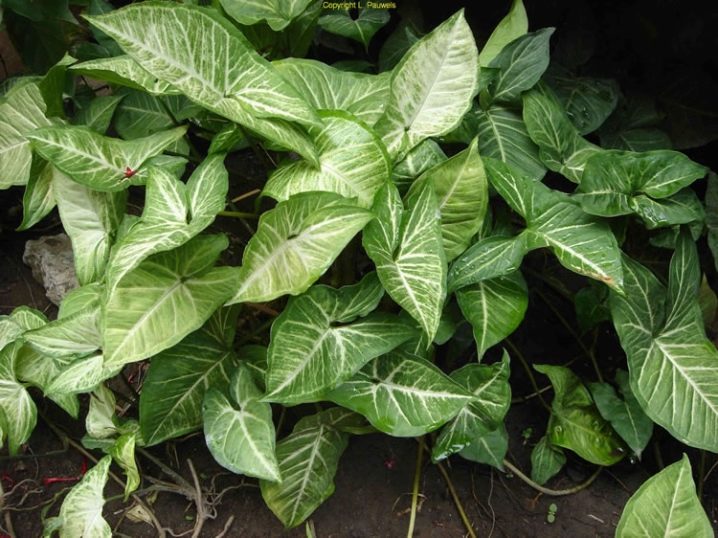
- Syngonium Wendland interesting in that its leaves have a very rich dark green color, and they are velvety to the touch. The formed sheet is divided into 3 segments. In addition, the Wendland syngonium leaf has a distinct central vein.
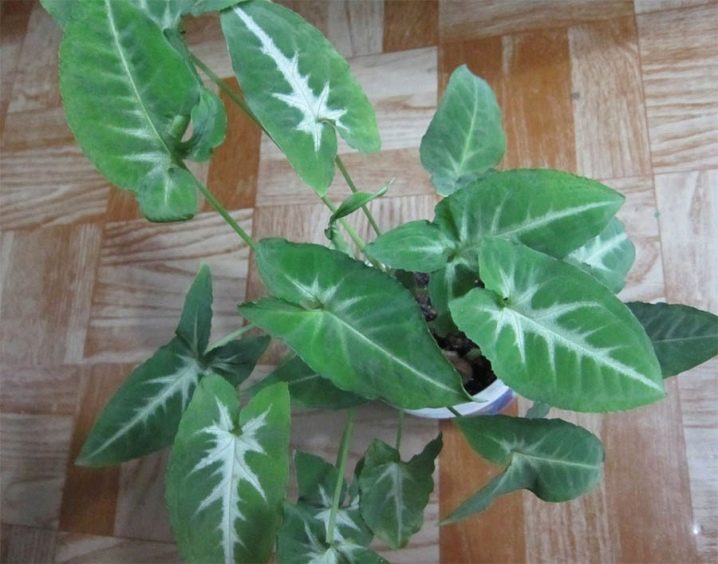
On the basis of these varieties, breeders have developed new varieties with original names. All of them are adapted for growing at home. Let's get acquainted with the variety of types and forms of the syngonium in more detail.
- "Scrumbled"... This rare variety of liana is notable for the fact that it has large leaves of a dark green variegated color, and there is a wide white vein in the center of the leaf. The leaf looks quite decorative and has a velvety surface.
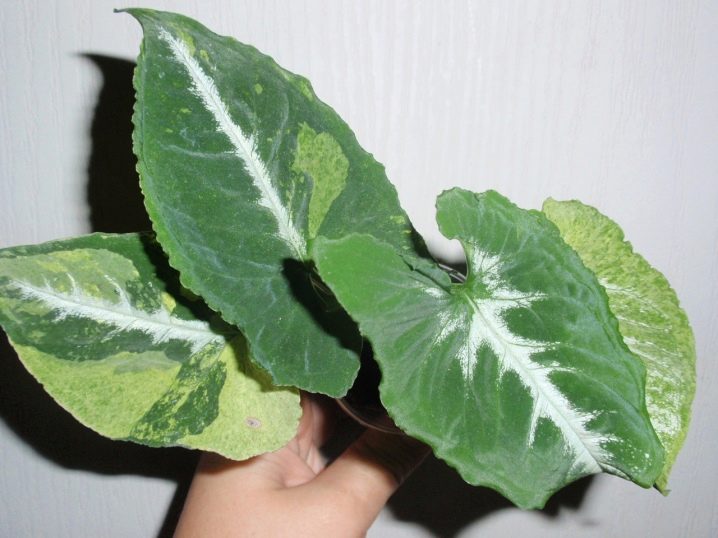
- "Panda"... The decorativeness of the plant lies in the fact that it grows in the form of a bush and has a beautiful leaf color. The color of the leaf is deep green with contrasting areas of yellowish-green blotches. The inclusions are large and randomly located.
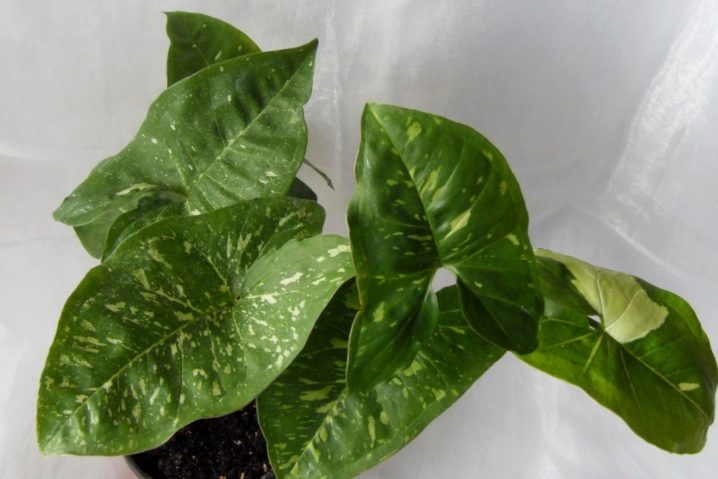
- "Pixie". A perennial liana with small leaves, the color of which is glossy, light green. The decorativeness of the plant consists in the fact that light green veins pass through all the leaves, while the color of the veins looks like marble. The shape of the leaves resembles an elongated heart.

- Arrow. This plant is very common among flower growers, it has compact shoots, and the juicy green heart-shaped leaves have a marble color in the form of light veins. The plant is unpretentious in care and grows rather quickly.
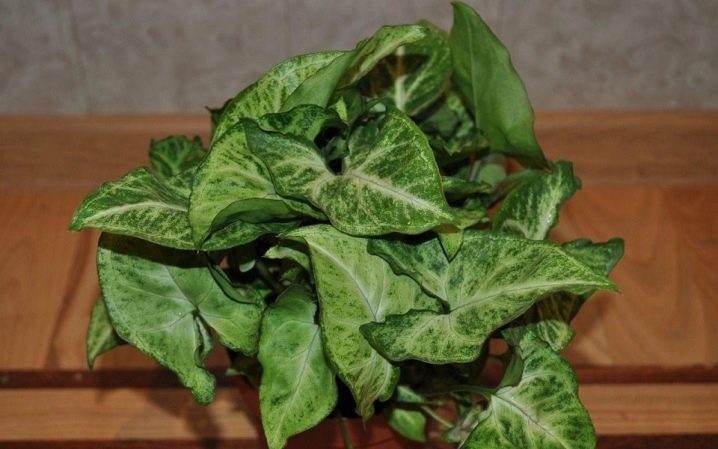
- "Butterfly". A fairly common variety, it is compact, grows quickly, propagates well by cuttings. The leaf shape is arrow-shaped and has a bright variegated light green color. The plant can grow up to 1.5 meters.
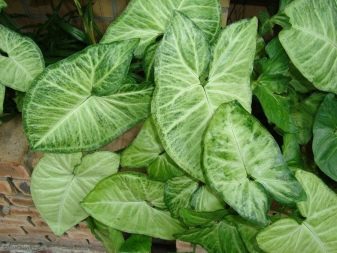
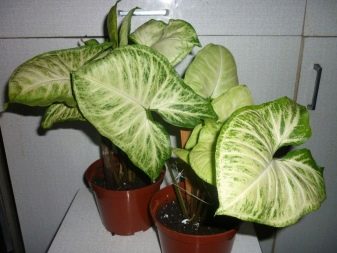
- "Neon". A unique decorative variety that has a delicate pink-green leaf color. The plant is quite capricious - it is important for it to match the moisture content, the stability of the air temperature and good lighting.
Not every beginner grower can cope with the maintenance of this rare variety of vines.
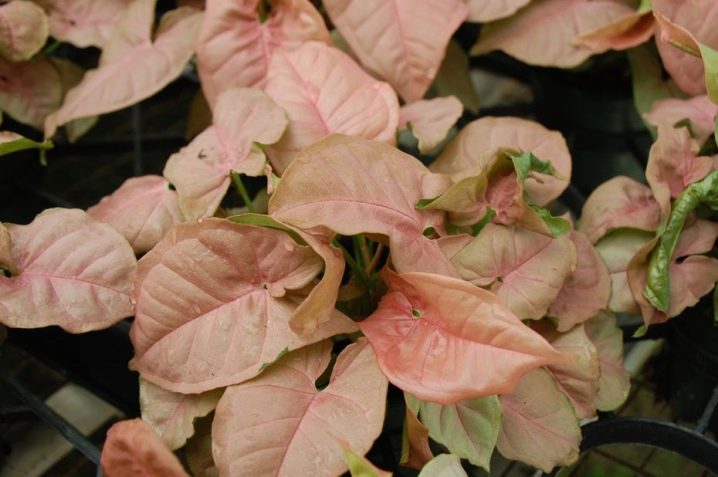
- Imperial White. It belongs to rare decorative varieties and is famous for having large leaves on long cuttings. The color of the leaf is unique - the main area of the leaf plate is white, it is complemented by dark green marble blotches. The intensity of the green shade is not uniform, which gives the flower a unique beauty.
To preserve the decorative color of the leaves, the flower needs a large concentration of nitrogenous substances in the soil.
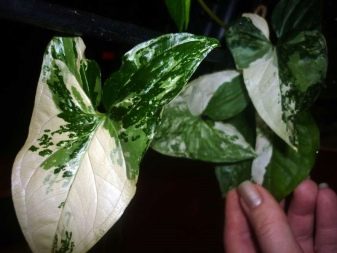
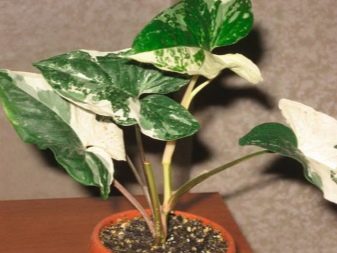
- Red Spot. This fast-growing vine is interesting in that it has arrow-shaped leaves with a rather interesting color. The leaf plate is painted with a combination of three colors - green, white and pink. On the same plant, you can see a pink leaf, either green, or a mixture of all three shades at the same time.
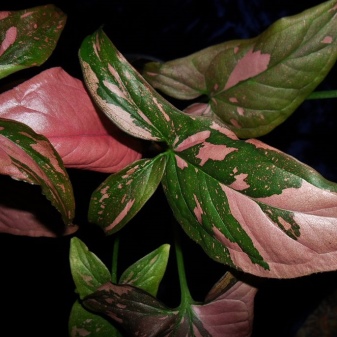
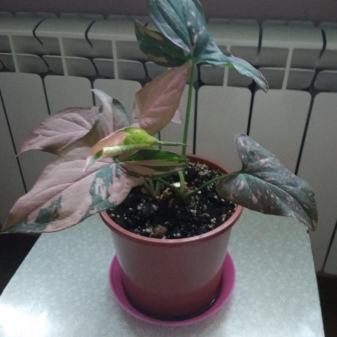
- "Christmas". You can identify this variety among others by the specific color of the leaves. On the bright green leaves of this vine, you will see streaks from light green to bright yellow. Moreover, the intensity of the yellow tint will directly depend on the brightness of the lighting - the more light hits the leaves, the more yellow it will be in its color.In addition, the leaves also have dark pink streaks.
This combination of colors makes the liana truly elegant and festive.
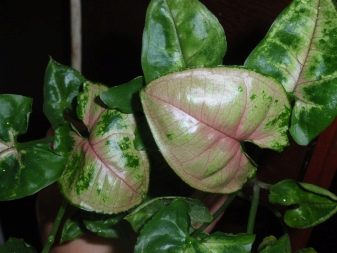

- Regina. This variety is similar to the Neon variety, as it has the same pink tint in the color of the leaves. However, the difference here is that Regina's color is brighter and more saturated, and if you look at the reverse side of the leaf plate, we will see that it is green.
It is very important for this variety to provide good lighting, since with a lack of sunlight, the color of the leaves will quickly fade.
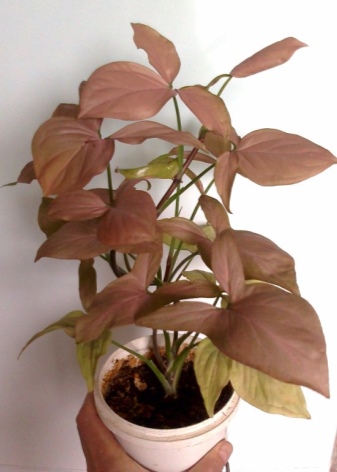
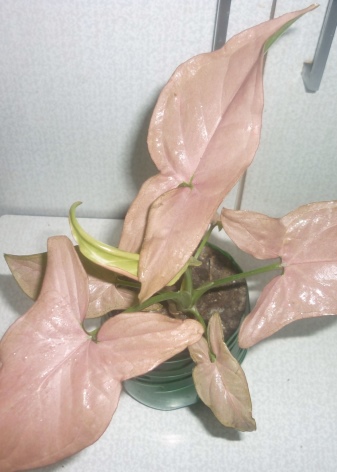
- "Pink splash"... This perennial is capable of growing up to 1.5 meters. The foliage has an oblong-elliptical shape and a dark green color. The decorativeness of the plant consists in the fact that there are chaotically located pink spots on the leaves. The plant grows quickly and does not require any special care.
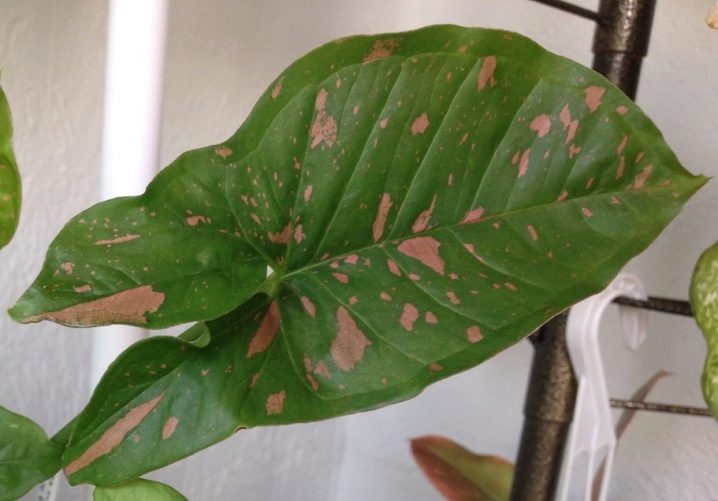
- Tiffany. Liana is quite compact, the leaves are medium-sized, glossy, slightly wavy. Leaf color is bright green, saturated. Its decorativeness lies in the fact that the leaves have veins, painted either in a light green shade, or it is a combination of green and pink tones.
The pink tint is not found on every leaf of the plant; its presence depends on the concentration of light falling on the leaf plate.
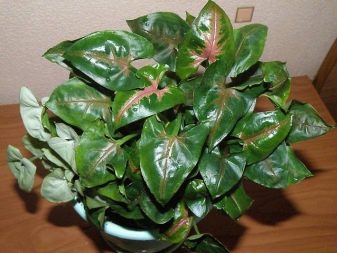
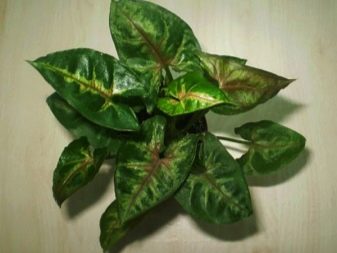
- Three Kings. Quite a common liana, unpretentious to the conditions of detention. Leaves are of medium size, elongated-arrow-shaped, divided into segments. The color of the leaves is bright green with pale green and even white spots. The spots are large, can occupy up to 2/3 of the leaf, giving the plant a special decorative effect.

- "Confetti". The plant is compact, the leaves are of medium size, the shape of the leaf structure resembles an arrow extended towards the base. The color of the leaf plate is pale green, even lighter veins are visible. On the leaves, in a chaotic manner, there are small spots of pinkish color.

- Orm manee. Compact bushy perennial vine. Propagated by cuttings, its leaves are elongated, arrow-shaped, segmented. The color of the leaf is pale green, the veins are pronounced, of a darker green hue.
The plant grows and develops quickly, it is undemanding to care, but it needs good lighting.
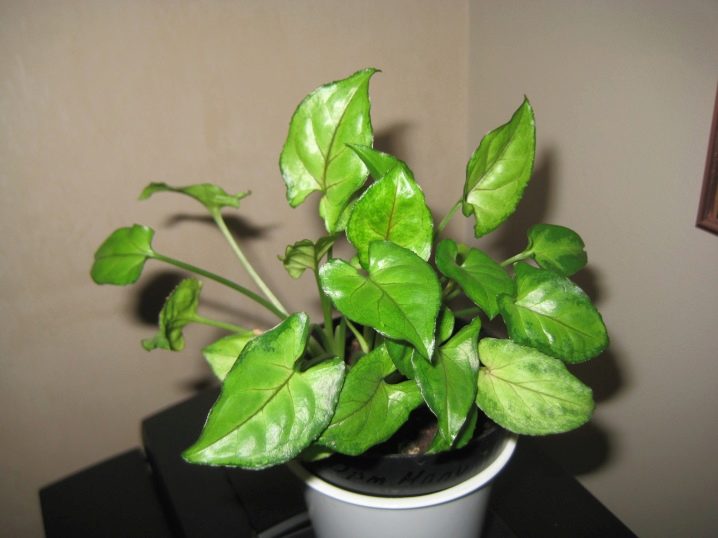
- "Auritum". This is the ear-shaped syngonium. Liana differs from its fellows in that it has strong climbing shoots and colorful green foliage. This plant can be a kind of backdrop for other flora in your home garden. Vine leaves are divided into segments - there can be from 3 to 5 of them.
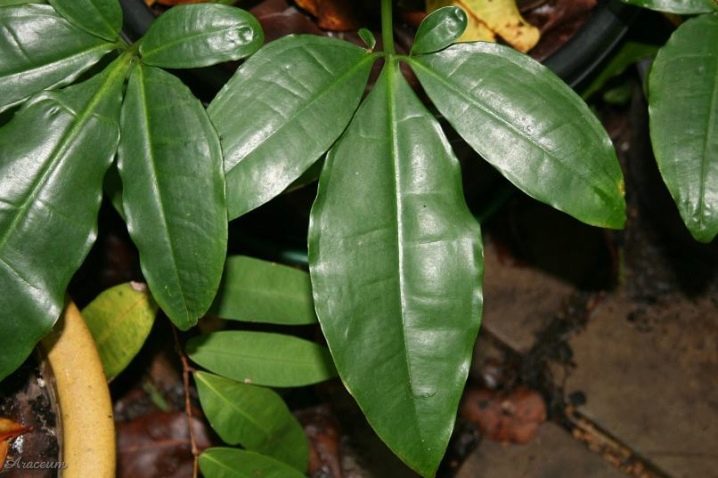
- "White Butterfly". A fast-growing liana, the leaves of which are completely or zonal brightened in the direction from the central vein. Sometimes the color of the foliage can be almost white. The decorativeness of the color depends on the amount of nitrogen in the soil. The shape of the leaves resembles a spearhead.
Perennial grows quickly and is undemanding to care for.

- Spear point. This is a rather large and strong representative of syngoniums, since its internodes, leaves and their petioles are very large. The most beautiful variety "Spear point" looks when it is planted in pots with the possibility of attaching vines to a support located in the vertical direction. The leaf shape of this perennial is pointed and elongated, reminiscent of the blades of knives. The leaf itself is divided into 3 well-defined segments. The color of the leaves is emerald green, and the veins are slightly lighter.
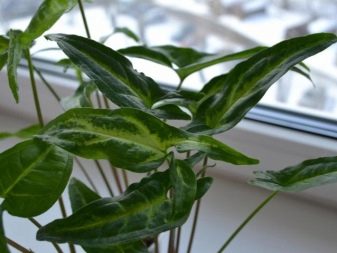
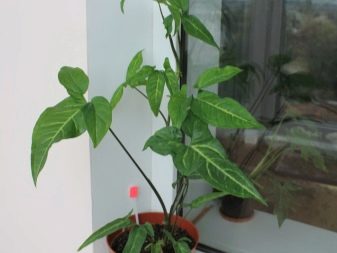
- "Tricolor". The plant has a highly decorative color of its leaves. The shape of the leaf plate resembles an elongated heart, and their color combines three colors - green, white and pink.
The intensity of the leaf color depends on the illumination and the presence of nitrogenous compounds in the soil.
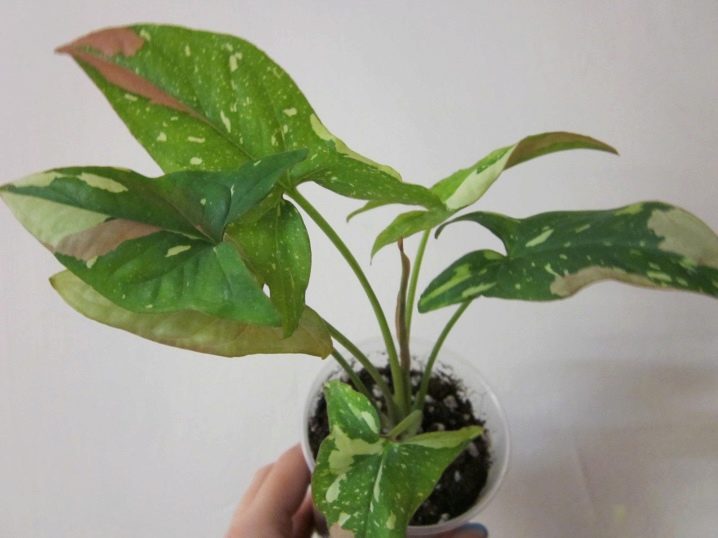
- Albolineatum. Vines have large, 25 to 30 centimeters, arrow-shaped leaves. The leaf color is bright green, the veins can be pale green or yellowish. With good feeding and bright lighting, the leaf veins turn yellow.Syngonium "Albolineatum" grows rapidly and is unpretentious in care.
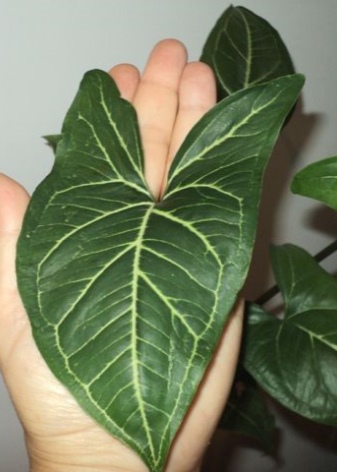
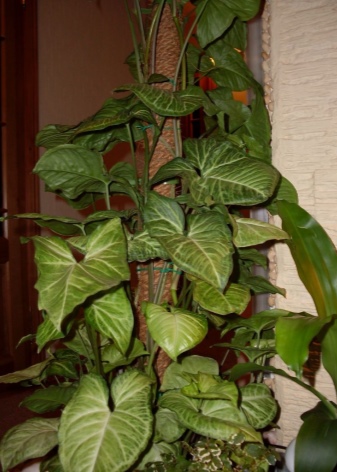
The species diversity of these tropical lianas, as well as their ability to grow rapidly, is successfully used for landscaping almost any interior. Evergreen syngoniums take root well and do not require complex care procedures.
Home care
Before starting a vine at home, novice flower growers wonder whether syngonium is poisonous or not. The answer to this question is unambiguous - the plant really has a certain degree of toxicity, therefore, when working with it, you need to take care of the means of protection for the skin of the hands. Besides, care must be taken to ensure that pets and small children do not have access to the flower and do not eat it.
On specialized forums, experienced florists leave their reviews about this evergreen perennial and share the secrets of how to properly care for it. There is almost unanimous opinion that caring for a vine is not difficult if you know how to do it correctly.
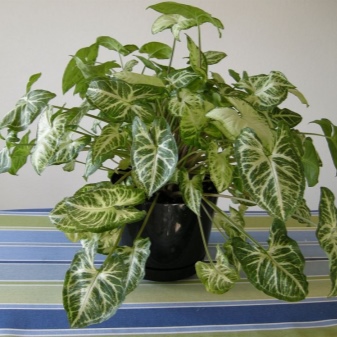

Site selection and lighting
Since the vine grows in natural conditions in the shade of the forest, the most favorable place in your house will be a window facing the east or west side for it. In summer, the plant can be rearranged to the north side. But the southern windows are completely unsuitable for syngonium. - here the plant will be overdried, and too bright sun exposure will discolor the color of the leaves.
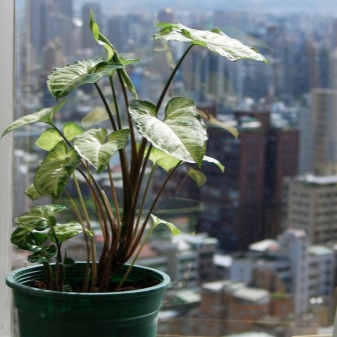
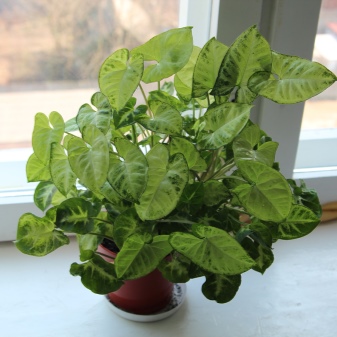
Temperature
The best temperature regime for keeping a flower can be considered the range is from 20 to 25 degrees in the spring-summer period and not less than 16-17 degrees in the winter season. You can correct the temperature background by frequently spraying the air around the vine and its foliage itself, as well as placing the plant pot on a pallet with moistened expanded clay.
It is necessary to ensure that the vine is protected from heating and other heating devices, as well as from the aggressive effects of the scorching sun.


Watering and fertilizing
For watering the plant, you should use water that has settled at room temperature, you can also spray the plant with the same water. Despite the fact that the vine loves moisture, watering it should be moderate. Watering is necessary when the topsoil dries up. Excessive moisture and sour soil, as well as lack of water, can destroy syngonium. In spring and summer, the plant should be watered abundantly, and excess water from the sump should be removed immediately. In the autumn-winter period, watering must be reduced.
It is advisable to apply fertilizers during watering in spring and summer to enhance the growth of vines. In winter, the plant has a dormant period, so there is no need to feed it. Fertilizers are applied by any (but not containing calcium) with a frequency of 1-2 times during each month... After rooting, young plants begin to feed only 1-2 months after planting.
Varieties with highly decorative foliage color require an increased content of nitrogenous components.

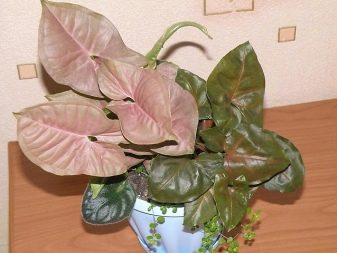
Transfer
Evergreen liana requires loose and light soil for unhindered access of air and water to the root system. The composition of the soil for syngonium includes peat, leaf humus, coarse river sand, moss and turf. All components are taken in equal amounts and mixed. When transplanting, a drainage layer is placed on the bottom of the pot. In addition, a vertical support must be immediately installed in the container and only then the plant is planted.
Usually, a vine tolerates a transplant well, but at the same time, it is best not to disturb an earthen lump. - just remove dead or damaged roots. After you have planted the plant, it must be watered abundantly with water.
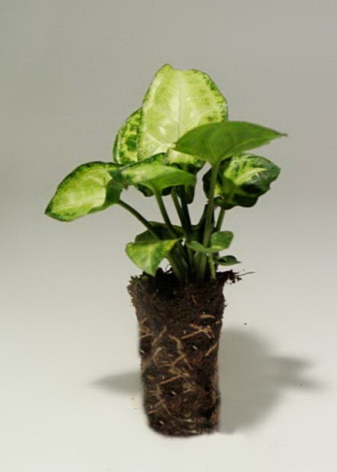
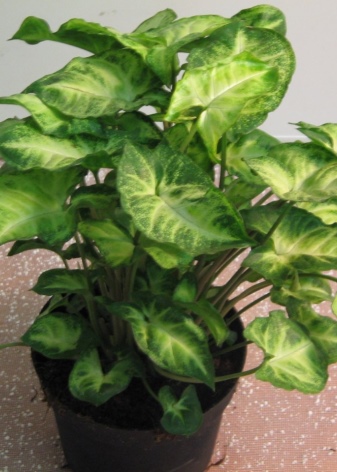
Garter
Tying up a fast-growing plant is necessary to give it a decorative look. As a rule, the garter is carried out around the vertical support installed in the pot. For this, a special floristic wire is used. It is necessary to carefully adjoin the plant to the support so as not to damage its shoots and leaves. Sometimes, instead of a garter, the plant is simply braided around the support, directing its growth in the right direction.
In addition to vertical supports, the vine can also be fixed along horizontal guides - it all depends on your preferences.
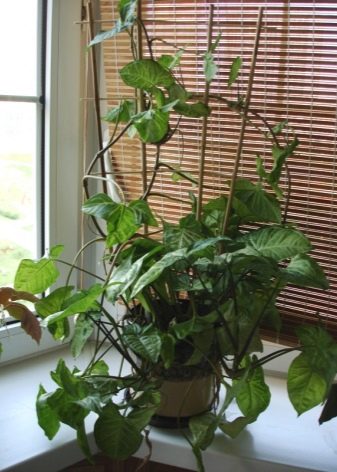
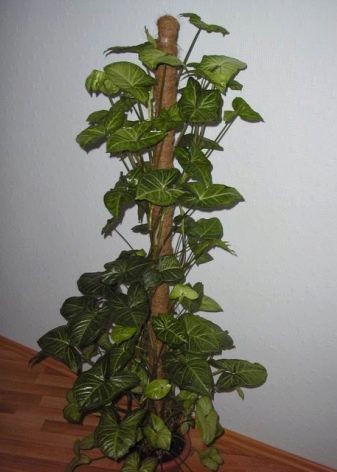
How to pinch?
In order for your syngonium to look beautiful, it is necessary to regularly form the crown. This can be done by pinching. Its essence lies in the fact that each young shoot must be pinched at the level of 5 or 6 leaves. Sometimes pruning is used to form a compact bush. In this case, the grown shoots are shortened to the required length, and the cut material is rooted and again planted in a pot to the main plant.
In the case when the syngonium grows in hanging pots, it is necessary to pinch or cut off its shoots, guided by the same principle, taking into account the desired length.
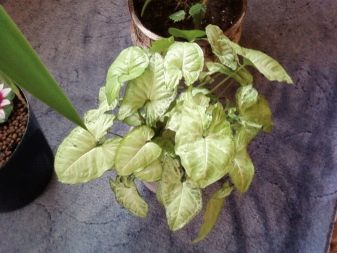

Bloom
It very rarely happens that the syngonium blooms. Its inflorescence looks like a small ear surrounded by a pale green veil. After a while, the color of the bedspread becomes pinkish. The life of a flower is very short and is only 3 days.
According to the reviews of florists, syngoniums look especially good at a young age, so it is advisable to periodically update the plant by propagating it by cuttings... Liana can stretch out from a lack of light - in this case, plant renewal is also necessary in order to preserve the decorative effect of your flower.
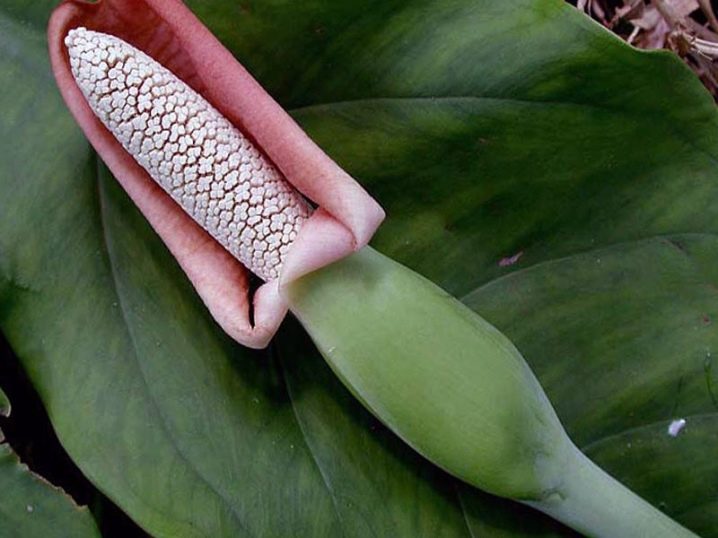
Reproduction
In order to propagate an evergreen vine, three methods are used:
- using the tops of the shootwhen a stalk with 2-3 young leaves and a living bud of an aerial root is cut off from the stem;
- using part of the stem with a living point of growth in the form of a bud - in this case, any part of the stem along its entire length is suitable for planting, you only need to cut off the stalk with a bud of the required size;
- using aerial roots - a part of the stem is used, on which the aerial layers of the roots have already formed.
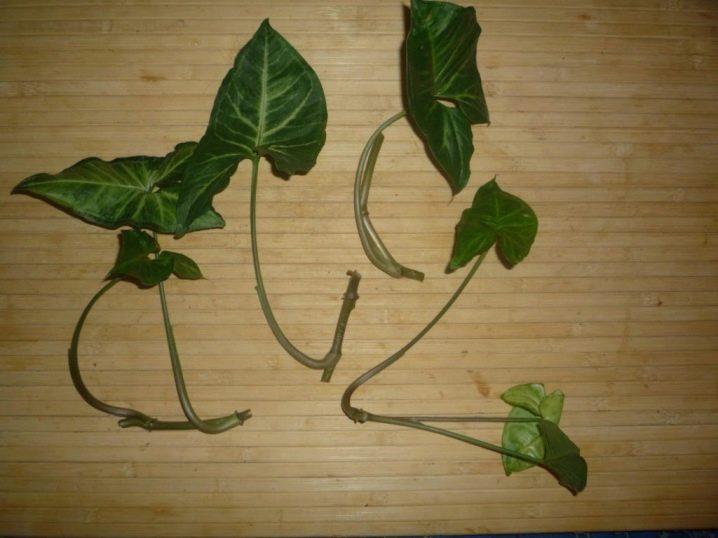
Having prepared planting material in one way or another, it is planted in a soil mixture consisting of peat, sand, turf, pine bark (or moss), taken in equal proportions. After planting, the cuttings are moistened, and the container where they are planted is covered with plastic wrap. Then, in order to root the plantings, they are placed in a warm and bright place. Every day, the film must be removed and the young seedlings must be ventilated.
In literally two weeks, young syngoniums will have roots (if you propagated them by cuttings), or, if these were cuttings with aerial roots that you planted in the soil, their rooting will occur. Now young plants can live without shelter under the film, developing independently and adapting to environmental conditions.
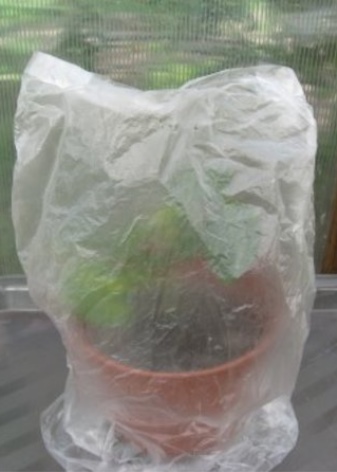
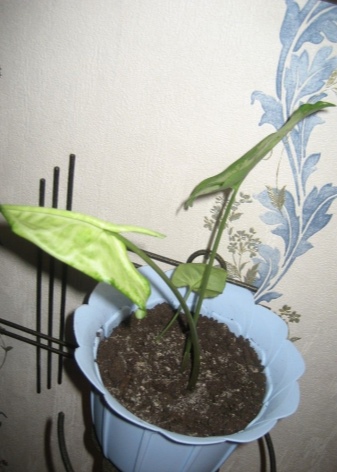
Diseases and treatment
The main causes of the disease of perennial syngonium are thrips, aphids and scale insects. When a plant is damaged by these pests, its growth slows down, leaf plates are deformed and even twisted. Spraying the plant with a soapy solution (20 grams of liquid soap diluted in 5 liters of water), and then treatment with an insecticidal agent will help to solve the problem. After carrying out such procedures, the damaged parts of the plant are removed and it is transplanted into a new pot with fresh soil.
It happens that the leaves of the syngonium turn yellow - in this case, you need to do those measures that will ensure a sufficient supply of nutrients to the vine. First of all, you need to check if the soil in the pot has acidified from excessive watering, and if this is the case, then you should urgently transplant the flower into another soil substrate. If this is not the reason, then, most likely, your flower does not have enough mineral fertilizing and its introduction will help solve the problem.
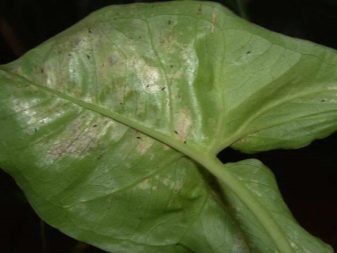
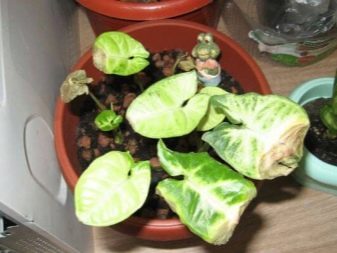
Often, in rooms with dry air and high temperature conditions, syngonium leaves appear rusty brown spots. In addition, in this case, even the tips of the sheet may begin to dry.... To stop the death of a plant, it is necessary to increase the level of humidity near it and move the flower to a place with a favorable temperature range for it.
On the forums of flower growers, you can often come across the question of how to return variegation to a decorative vine. The color of the leaves of the plant may fade or disappear altogether if there is not enough sunlight for it. If you notice that natural lighting is clearly not enough for the flower, you will need to apply artificial supplementary lighting using special phytolamps.
If necessary, such a lamp shines on the plant even at night - this is especially true in winter.
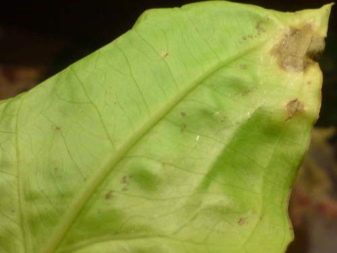

For more information on caring for the syngonium, see the next video.























The comment was sent successfully.